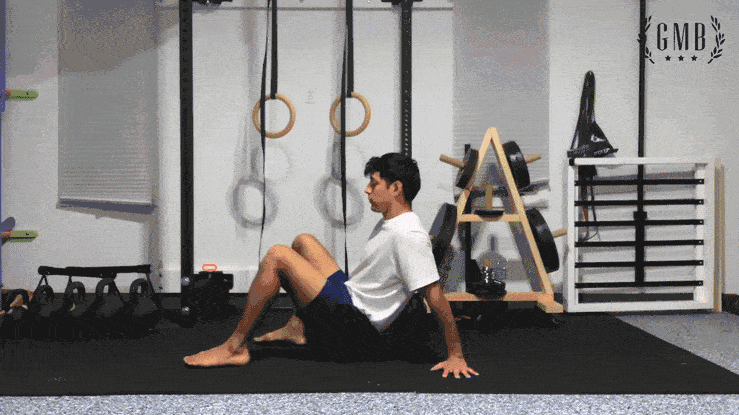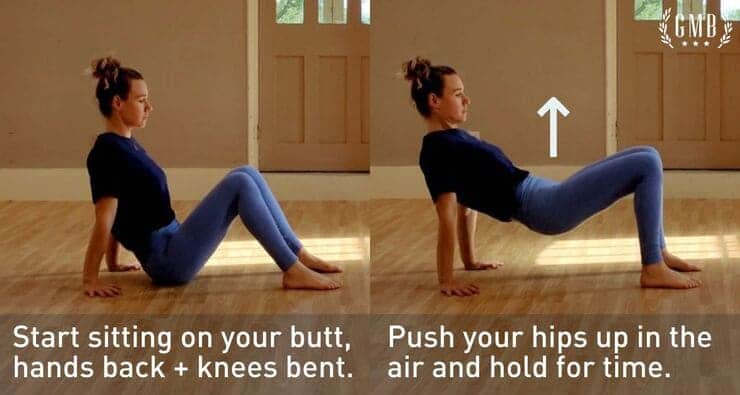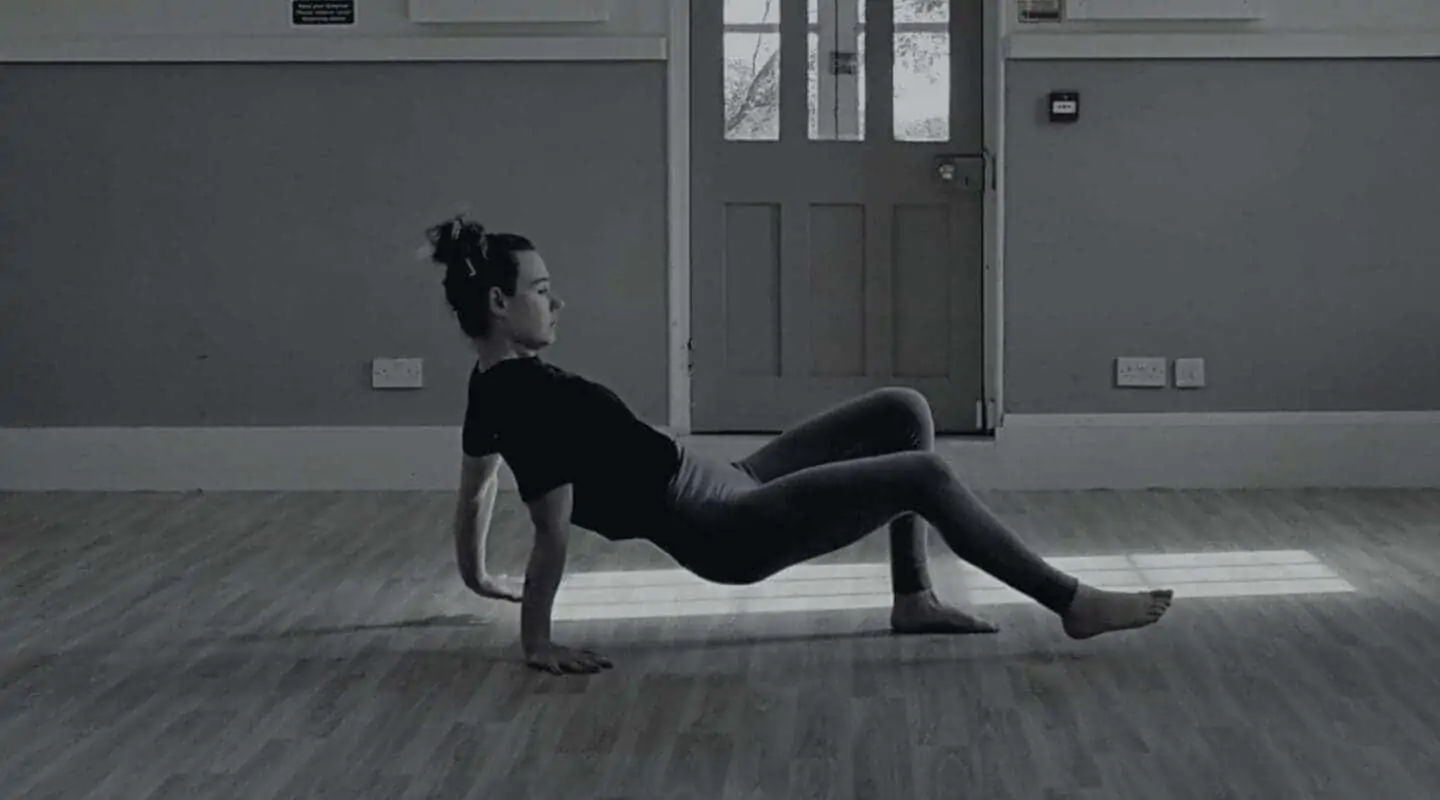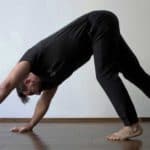Crab walks 🦀 were fun to do as a kid on the playground. But did you know they’d be a beneficial movement you could keep doing into adulthood?
When you’re crawling around like a crab, we call this type of movement locomotion, which means to move your full body through space. The Crab is great for building strength and flexibility throughout the chest, shoulders, and back, among other benefits we’ll get into below.
The Crab is known as an “animal” movement, similar to the Bear or Frogger that have been used in martial arts, gymnastics, strength and conditioning programs, and playground games.
And while you might have played around walking around like a crab as a kid, there’s a lot of athletic benefits to be gained from doing this movement regularly.
How To Do The Crab Walk

- Step 1: Sit on your butt with both hands behind you, palms flat on the floor, with your knees bent, and feet flat on the ground about hip-width apart.
- Step 2: Lift your butt up so only your feet and hands are touching the ground.
- Step 3: With your hips off the ground, step forward with left foot and right hand, and then repeat with opposite foot and hand to walk forward or backward.
Notes on the Crab Walk:
A good rule of thumb is to keep your hands and feet as close to your body as possible. Some people try to reach their hands too far behind them, and that makes the movement much harder and less stable.
Another idea to keep in mind is that you want your shoulders away from your ears. In other words, you want to pull your shoulders down and back. This will also help keep your butt off the ground.
Since this movement has you supporting your weight on your hands, wrist pain might be an issue. If so, check out our guide for building wrist strength and flexibility.
The Crab requires decent shoulder strength, so if it’s extra tough for you, check out the Bear and strong shoulder guide.
Crab Walk Variations For Stability And Body Control
Below you’ll see 4 variations of the Crab Walk that we use in our programs.
- Basic Crab Walk – straight arms, bent legs, forward and backward movement
- Crab Underswitch To Table Top – straight arms, bent legs, core rotation to the table top position
- Crab Lateral Walks – straight arms, bent legs, side-to-side lateral movement
- Crab Walks Underswitch To Table Top – straight arms, bent legs, forward and backward movement, core rotation to the table top position
Depending on your level of ability, one variation may come easier than another one, so we recommend you work on a variation you can do with good form and that is challenging to you.
For instance, if you want to work on building more shoulder stability, you could focus on the Crab Underswitch To Table Top instead of the lateral walks.
Once you get stronger with the underswitch, you can explore other variations with your newfound shoulder stability.
What If I Can’t Do The Crab Walk Exactly Like They Are In The Videos? 🤔
You don’t have to do it exactly the way we are. In fact, if you’re struggling, a good thing to practice is simply getting into the reverse table top position like this:

From there, you can hold this position for time. If it’s difficult, simply hold for as long as you can, even if it’s only 1 or 2 seconds. From there, aim to hold for more time, like 10+ seconds per set.
This will help you get comfortable in the position and build up the shoulder and arm strength for the crab walk.
Crab Exercise Variations And Benefits
| Variation | Benefits |
|---|---|
| Basic Crab | • Scapular strength through concentric and isometric protraction, eccentric and isometric retraction, and eccentric control of elevation • Rotator cuff strength to control eccentric internal rotation and concentric, isometric external rotation • Spinal strength for isometric extension, rotation, and flexion • Hamstring and calf flexibility • Increase in hip strength and mobility • Increase in spinal extension strength and scapular depression |
| Crab moving right and left | • All the benefits from basic Crab + • Increased emphasis on motor control and coordination moving side to side |
| Crab under switch to floating table top and back | • All the benefits from basic Crab + • Increased emphasis on motor control and coordination flowing in and out of the movement |
As you’ll see, the Crab Walk requires full body strength and ability, and it will challenge you moving back and forth, as well as side-to-side in a somewhat awkward position.
It’s good for building strength through your shoulder blades and rotator cuff, as well as stability with your spine. You’ll also work on hamstring and calf flexibility, and build more mobile hips as well.
Getting comfortable with the Crab Walk allows for you to do other movements more efficiently, like the Monkey and Frogger.
Here’s GMB Trainer Verity doing a movement flow that incorporates various Crab variations as a part of her Elements training.
Using The Crab In Your Training
The Crab is great for helping you build coordination, control, and core strength in the supine position (belly up), which paves the way for skills like the L-sit, and being able to smoothly transition to other movements.
Hip strength and mobility are important for unilateral lower body movements, and the Crab pairs well with workouts centered around exercises like the pistol squat and shrimp squat. The Crab is also a good way to get some conditioning in when you work on it for a set period of time like we use in our programs.
Want to learn the Crab Walk and how to use it with other crawling patterns for a strong base of strength, mobility, and body control? If so, we recommend getting started with Elements.
Be Stronger & More Capable With a Foundation in the Basics
With Elements, you’ll get strong, flexible, and agile using various animal movements, helping you move well without restriction.



